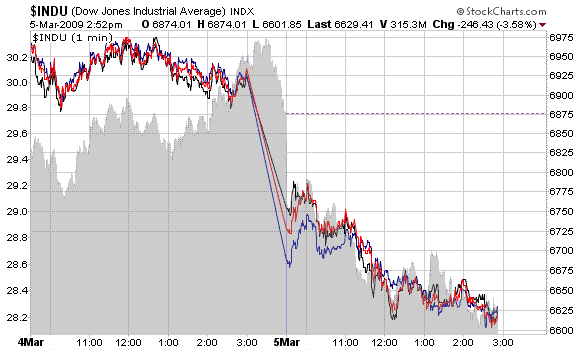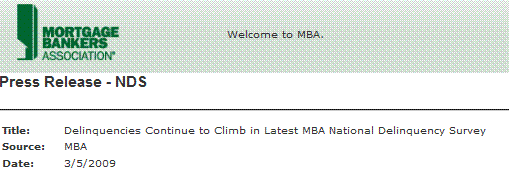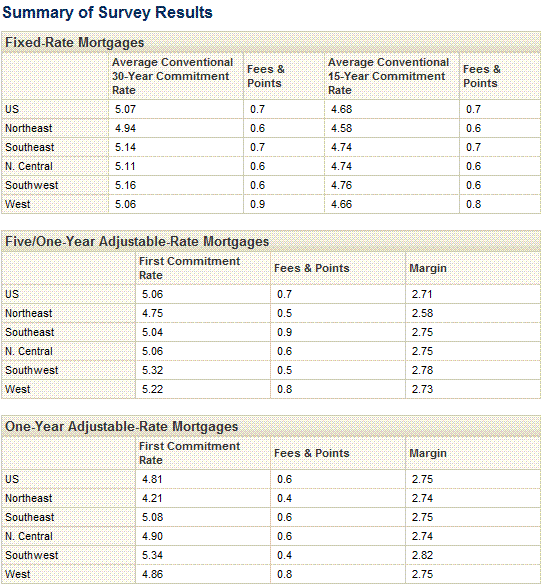WE HAVE GOTTEN REPRICES FOR THE BETTER as MBS has continually improved throughout the day, market participants moving down in coupon. <--YAY
Rate sheets are markedly improved from yesterday...
Stocks move lower led by financial stocks. Treasury yields lower.

Chalk up another $63bn in Treasury Supply....


The delinquency rate breaks the record set last quarter and the quarter-to-quarter jump is the also the largest. The records are based on MBA data dating back to 1972
WASHINGTON, D.C. (March 5, 2009) - The delinquency rate for mortgage loans on one-to-four-unit residential properties rose to a seasonally adjusted rate of 7.88 percent of all loans outstanding as of the end of the fourth quarter of 2008, up 89 basis points from the third quarter of 2008, and up 206 basis points from one year ago, according to the Mortgage Bankers Association's (MBA) National Delinquency Survey.
The delinquency rate breaks the record set last quarter and the quarter-to-quarter jump is the also the largest. The records are based on MBA data dating back to 1972.
The delinquency rate includes loans that are at least one payment past due but does not include loans somewhere in the process of foreclosure.
The percentage of loans in the foreclosure process at the end of the fourth quarter was 3.30 percent, an increase of 33 basis points from the third quarter of 2008 and 126 basis points from one year ago.
The combined percent of loans in foreclosure and at least one payment past due was 11.18 percent on a seasonally adjusted basis and 11.93 percent on a non-seasonally adjusted basis. Both of these numbers are the highest ever recorded in the MBA delinquency survey.
The percentage of loans on which foreclosure actions were started during the fourth quarter was 1.08 percent, up one basis point from last quarter and up 20 basis points from one year ago.
The percentages of loans 60 days past due, loans 90 days or more past due, and loans in foreclosure all set new record highs, breaking records set last quarter. The percentage of loans on which foreclosure actions were started tied the record set in the first quarter of 2008. The percentage of loans 30 days past due is still well below the record set in the first quarter of 1985.
Increase in Delinquencies Show Spreading Impact of Recession
"Foreclosure inventory jumped sharply in the fourth quarter even though the rate at which loans were entering foreclosure remained unchanged," said Jay Brinkmann, MBA's Chief Economist and Senior Vice President for Research and Economics. "This is mainly attributable to various state and local moratoria on foreclosure sales, the Fannie Mae and Freddie Mac halt on foreclosure sales announced in late November, a general reluctance by servicers to proceed with evictions in the last few weeks of December and a slowing down caused by an overburdened legal process in some areas."
"The rate of new foreclosures has remained essentially flat for the last three quarters of 2008. This might be seen as a good sign for mortgage performance, but most other measures point to exactly the opposite conclusion. The percentage of loans 90 days or more past due jumped sharply in the fourth quarter. Normally servicers would have initiated foreclosure actions on a significant portion of these loans but delayed doing so for a variety of reasons, including working on loan modifications, complying with the guidelines of different investors, and various delays in different locales. In addition, some servicers report a spate of borrowers running their accounts 90 days delinquent in order to qualify for certain modifications," Brinkmann said.
"Subprime ARM loans and prime ARM loans, which include Alt-A and pay option ARMs, continue to dominate the delinquency numbers. Nationwide, 48 percent of subprime ARMs were at least one payment past due and in Florida over 60 percent of subprime ARMs were at least one payment past due.
"We will continue to see, however, a shift away from delinquencies tied to the structure and underwriting quality of loans to mortgage delinquencies caused by job and income losses. For example, the 30-day delinquency rate for subprime ARMs continues to fall and is at its lowest point since the first quarter of 2007. Absent a sudden increase in short-term rates, this trend should continue because the last 2-28 subprime ARMs (fixed payment for two years and adjustable for the next 28 years) were written in the first half of 2007. The problem with initial resets is largely behind us, although the impact of the resets was generally overstated.
"The delinquency rates continue to climb across the board for prime fixed-rate and subprime fixed-rate loans, loans whose performance is driven by the loss of jobs or income rather than changes in payments," Brinkmann said.

MORTGAGE RATES LITTLE CHANGED LAST WEEK
McLean, VA - Freddie Mac (NYSE:FRE) today released the results of its Primary Mortgage Market Survey® (PMMS®) in which the 30-year fixed-rate mortgage (FRM) averaged 5.07 percent with an average 0.7 point for the week ending February 26, 2009, up from last week when it averaged 5.04 percent. Last year at this time, the 30-year FRM averaged 6.24 percent.
The 15-year FRM this week averaged 4.68 percent with an average 0.7 point, unchanged from last week when it averaged 4.68 percent. A year ago at this time, the 15-year FRM averaged 5.72 percent.
"Mortgage rates were little changed this week amid mixed data reports of a slowing economy," said Frank Nothaft, Freddie Mac vice president and chief economist. "Both the core Producer Price and Consumer Price Indexes ticked up in January, higher than the market consensus, while consumer confidence in February fell to the lowest reading since records began in January 1967.
"Lower house prices and affordable mortgage rates have yet to spur housing demand. For instance, house prices declined by 8.7 percent for the 12 months ending in December 2008 and were down 10.9 percent from their highs set ion April of 2007, according to the Federal Housing Finance Agency's purchase-only monthly home price index. However, existing home sales (excluding condominiums and co-ops) fell 4.7 percent in January to 4.05 million units (annualized), the slowest pace since July 1997."






